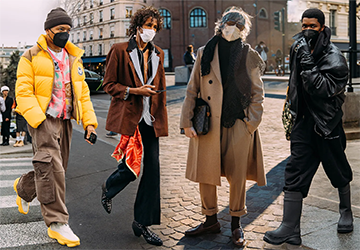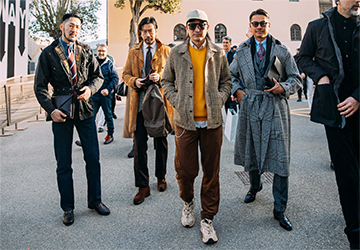The emergence of subcultures
Streetwear began as a subculture that originated in the skateboarding and hip-hop scenes of the 1980s. It's an expression of rebellion and individuality. It has become a global phenomenon initially viewed as a niche style for marginalized groups. The mainstream history of streetwear shows how the trend went from underground to widespread acceptance.
Factors driving growth
Celebrity
One of the critical factors in the evolution of streetwear is celebrity endorsement. Music, sports, and entertainment icons founded streetwear brands and propelled them to mainstream attention. Top-tier collaborations also play a role. The style has transcended its subcultural origins, as rappers, athletes, and luxury designers have begun endorsing or creating streetwear lines.

Social media and virality
Another aspect to consider is the impact of social media. Before the digital age, trends took time to spread. However, social media platforms allow streetwear to gain immediate global exposure. Limited edition releases and the use of influencers make every new launch an event and push streetwear to the next level.
Fashion Shows and Designer Brands
While the streetwear brand initially stayed away from the runways of Milan and Paris, it eventually became embraced by the fashion world. Luxury brands are beginning to incorporate streetwear elements into their collections, blending high fashion with urban style. This integration played an essential role in changing public perception, adding additional prestige and making it socially acceptable to wear these styles in a broader range of settings.
When change occurs
When did streetwear become popular? It's difficult to pinpoint an exact point in time, but the late 2010s can be considered a turning point, and it was at this time that more streetwear-inspired designs began to appear in fashion weeks. Mainstream retail stores expanded their streetwear collections, and even traditional media started to cover the trend extensively. Then, people realized that streetwear was no longer just a style but an essential part of the fashion industry.
Global impact
Today, streetwear is a multi-billion dollar industry with global influence. From Tokyo to New York, the style has influenced fashion, lifestyle, and even interior design. Mainstream streetwear's history has grown to the point where it's become an integral part of almost every clothing store. Collaborations between streetwear brands and luxury fashion houses are commonplace, further cementing their mainstream status.
Streetwear economy
While the style and spirit of streetwear has always been the most important aspect, its economic impact must also be considered. What was once a niche market now accounts for many of the fashion industry's sales. Limited releases (called "drops") have become a retail staple. These deals often create excitement, sell out within minutes, and then appear on resale platforms shortly after at significantly increased prices. The economic model of scarcity and hype drives mainstream streetwear and adds an element of exclusivity that makes it more appealing to a broader audience.
Cultural integration and globalization
In its early days, streetwear was primarily based on American urban culture. However, as the style gained mainstream attention, it began incorporating elements from different cultures. From Japan's Harajuku scene to the vibrant street styles of London and Paris, streetwear has become a melting pot of global influences. This diversity has contributed significantly to the development of streetwear, making it adaptable and relevant across continents.

Sustainability and streetwear
As environmental issues gain global attention, the fashion industry, including streetwear, is being scrutinized for its environmental impact. Many brands have begun to address this issue by incorporating sustainable practices into their production methods. Organic cotton, recycled materials, and ethical manufacturing are becoming increasingly common in streetwear. This shift toward sustainability is a new but essential chapter in the history of mainstream streetwear, demonstrating the industry's adaptability and responsiveness to current issues.
Technology Impact: From Blogs to Apps
The rise of the internet has been a significant trend since streetwear became popular. In the early days, forums and blogs were the most important platforms where enthusiasts could share new releases, exchange articles, and discuss trends. Today, exceptional apps and platforms have explicitly emerged for streetwear. These platforms act as marketplaces and social media networks where users can share their outfits, tips, and reviews.
The role of music festivals and events
Music has always been closely associated with the development of streetwear, hip-hop, and rock genres. This trend has gained momentum recently, with music festivals becoming fashionable events in their own right. Attendees wear the styles; brands even sponsor events to showcase their latest collections. Events like this provide established and emerging streetwear brands an authentic platform to engage directly with their audiences.
The intersection of streetwear and digital art: the new frontier of fashion and creativity
As we move into an increasingly digital world, streetwear is beginning to intersect with digital art and cryptocurrency. From unique NFTs tied to physical clothing to virtual streetwear collections incarnated in the digital space, this merger sets new trends.
The future has not been written yet.
When did streetwear become popular? Despite its many milestones, it's clear that streetwear is an ever-evolving phenomenon. Its roots remain in subculture, but its branches extend into mainstream fashion, business, and political discourse. What will be the next phase in the evolution of streetwear? It's hard to say, but given its history of adaptability and influence, the style is here to stay.
Diploma
The evolution of streetwear is a testament to the power of subcultures and their ability to influence mainstream culture. What started as a style for rebels and outcasts has become a universal fashion language. When did streetwear become popular? It was a gradual process, but its impact is undeniable, as today's mainstream success shows. Whether you're a skateboarder or a CEO, streetwear has something for everyone, and its evolution is far from over.